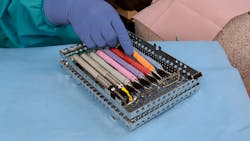Top 5 reasons your dental practice should consider instrument cassettes
It’s a commonly held belief that if something is effective, it’s not simple. Conversely, if something is simple, then it can’t be effective. But that isn’t always true. My Starbucks app is extremely user-friendly. And with a few taps, I can preorder my Venti Cinnamon Dulce Latte with almond milk and have it ready and waiting for me by the time I arrive. Easy and helpful! The same can be said of instrument management systems.
Cassette-based instrument management systems have been around for decades and are a proven method for reducing compliance risks while increasing safety and efficiency. Yet, as the dental industry continues to respond to the COVID-19 pandemic, the area of instrument reprocessing and sterilization needs to be revisited with greater scrutiny. Just as PPE usage and patient intake-outake flow have evolved, cassettes are the right choice for any practice now more than ever.
Take for example the case of Pacific Dental Services (PDS). PDS has more than 700 offices across the United States with plans for even greater expansion. With such a large organization, efficiency is paramount. In order to maximize productivity while still being mindful of safety, PDS turned to their long-time partner, Hu-Friedy, to identify areas of improvement and to learn how instrument management systems could help improve efficiency and effectiveness.
PDS identified two offices—one in California and one in Colorado—to see how cassettes would affect overall outcomes. They could then determine if implementing cassettes on a larger scale would be beneficial to their group. The results of the trial were, quite simply, amazing. They learned that cassettes aren’t just effective and easy to use, but that they come with a host of other benefits.
Efficiency
At the dental practice, every minute counts. Saving a few minutes with each procedure or with each chore adds up over the course of the day. Because instruments don’t have to be scrubbed, sorted, or pouched manually, the PDS study revealed that each office was able to reprocess eight minutes faster than those offices doing them by hand. Eight minutes may not sound like much, but eight minutes here and there adds up to almost an extra hour each day. Put another way, it adds up to an extra month per year!
Instrument protection
Dental instruments are abundant in a practice, but they come at a steep cost. It is the price that we are willing to pay because we want patients to get the best care via the best equipment. But we don’t want to throw away money. If you’re not careful with instruments, the price tag for their replacement can escalate quickly. By keeping instruments together, the likelihood of dulling, breakage, and loss is reduced.
Cassettes are useful for keeping instruments in their proper cleaning positions. From a time standpoint, staff isn’t hunting around for lost instruments or ordering replacements. From a financial standpoint, they help practices protect their instrument investment. From a care standpoint, you don’t have to worry that the necessary tool won’t be available.
Team member protection
Sharps injuries are nerve-racking events, especially if the needle or instrument has already been used on a patient. Other than during use and disposal, the next greatest potential for a contaminated sharps injury is during instrument reprocessing. Cleaning instruments manually increases the risk of exposure by 31%. When cassettes are used, instruments are securely and safely maintained. In fact, the PDS study revealed that the two dental offices piloting the cassette program had zero incidents of sharps injuries.
The Occupational Safety and Health Administration (OSHA) mandates under their General Duty Clause that employees be furnished with a workplace free from hazards. Part of the practice’s OSHA Exposure Plan details how the employer is to accomplish this and includes the use of engineering controls like cassettes. With cassettes, the only time staff members come into direct contact with instruments is in the operatory with patients. When the instruments are transported or reprocessed, instruments are kept in a cassette, reducing the risk of staff injury or exposure to blood-borne pathogens.
Instrument organization and management
Especially in the sterilization area, it’s hard to keep track of all the practice’s instruments. When I think about the sterilization areas I see when consulting at dental offices, space is at a premium. Counter space seems to disappear as soon as it opens up, causing the room to feel even more claustrophobic. Cassettes help bring order to the chaos.
There’s a reason why Marie Kondo became a household name. People in general dislike clutter. According to some studies, it induces anxiety, creating a low-grade and chronic fight-or-flight response. This can tax a dental professional physically and mentally. Cassettes as part of the instrument management system can help improve organization and provide peace of mind.
Another bonus is faster onboarding of new staff members. According to BambooHR, properly onboarded employees are a whopping 18 times more committed to the business than employees who receive inefficient onboarding. In addition, the extra time spent training new employees can add up. The same study estimated this to be $4,125 on average. A color-coding system shows, precisely, where instruments go in the cassettes. That means when a new team member is hired, he or she can quickly assimilate into the practice’s workflow, further benefiting the practice financially and with increased team satisfaction.
Patient perception
Impressions matter, and what patients see from the minute they enter your practice has an impact. It’s true of the reception desk, it’s true of your personal appearance, and it’s certainly true of the instruments in the operatory. Patients are more cognizant of infection control risks than ever before. They’ve seen the news stories about the bad things that have happened in practices around the country. Seeing a tray of damaged instruments—or even just one damaged instrument—will set off alarm bells.
A cassette system helps put patients at ease. Instruments are neatly, cleanly organized and packaged. Then, they are opened in front of the patient in accordance with guidelines from the Centers for Disease Control and Prevention. It adds a professional luster to the practice, instilling more confidence and faith in your patients while protecting the clinician.
Practices that utilize an instrument management system are more efficient, effective, organized, protective, and patient-oriented than those without. Implementing cassettes can increase team morale from the very first day of use while reducing unnecessary costs. And as PDS and dental offices across the country know, simplicity and efficiency can coexist!
Additional articles:
About the Author

Karen Daw, MBA, CECM
Karen Daw, MBA, CECM, is an award-winning national speaker, author of numerous articles and CE courses on safety in dentistry, and a trainer for practices and health-care systems across the country. She earned her BA from Ohio State University and her MBA with concentrations in healthcare administration and business management. After graduating, Daw was recruited from the emergency department to become assistant director of sterilization monitoring and health and safety director for the OSU College of Dentistry. She is a proud member of the Organization for Safety Asepsis and Prevention, where she served as cochair for their annual conference and infection control boot camp.
Updated December 14, 2021

